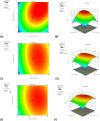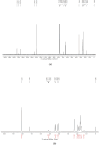Valorization of wood waste for enhanced polyhydroxybutyrate production by Klebsiella sp. MK3
- PMID: 40414903
- PMCID: PMC12104425
- DOI: 10.1038/s41598-025-01305-7
Valorization of wood waste for enhanced polyhydroxybutyrate production by Klebsiella sp. MK3
Abstract
The valorization of wood waste as a sustainable bacterial feedstock for the production of Polyhydroxybutyrate (PHB) is explored in this study, aiming to provide an environmentally friendly alternative to conventional plastics. Wood waste, treated with 4% sulfuric acid, served as the carbon source for isolating bacteria from Jalandhar waste streams, with the strain Klebsiella sp. MK3 identified as the most effective in PHB production after 16s rRNA sequencing. Analytical methods including the Molisch test, DNS, and sugar utilization tests confirmed sugar presence and consumption by the bacterial isolate. Media optimization using Design Expert 12.0 utilized a quadratic model, achieving a robust fit with an R² value of 98.6%. Optimization via Plackett-Burman design and response surface methodology enhanced PHB yield to 4.37 mg/mL, a significant increase over previous benchmarks. This yield was achieved under optimal conditions of 1.7% carbon concentration, 0.105% nitrogen concentration, and a constant temperature of 37 °C. Qualitative analysis of PHB by UV-Vis spectroscopy, FTIR, and NMR confirmed its purity and composition. The study highlights the potential of wood waste and wastewater as substrates for cost-effective PHB production, with significant applications in packaging, agriculture, medicine, and more, thus promoting reduced reliance on non-renewable resources and advancing sustainability goals.
Keywords: Klebsiella sp. MK3; Plackett-Burman design (PBD); Polyhydroxybutyrate (PHB); Response surface methodology (RSM); Statistical experimental design.; Wood waste valorization.
© 2025. The Author(s).
Conflict of interest statement
Competing interests: The authors declare no competing interests.
Figures









Similar articles
-
Unlocking sustainable solutions: wood waste as a novel substrate for polyhydroxybutyrate (PHB) production to combat plastic pollution.Environ Technol. 2025 Apr;46(11):1909-1921. doi: 10.1080/09593330.2024.2409994. Epub 2024 Oct 10. Environ Technol. 2025. PMID: 39390695
-
Optimization and characterization of polyhydroxybutyrate produced by Halomonas meridiana using orange peel waste.BMC Microbiol. 2025 May 19;25(1):304. doi: 10.1186/s12866-025-04007-2. BMC Microbiol. 2025. PMID: 40383787 Free PMC article.
-
Optimization and characterization of polyhydroxybutyrate produced by Vreelandella piezotolerans using orange peel waste.Sci Rep. 2025 Jul 16;15(1):25873. doi: 10.1038/s41598-025-10899-x. Sci Rep. 2025. PMID: 40670479 Free PMC article.
-
Critical overview of biomass feedstocks as sustainable substrates for the production of polyhydroxybutyrate (PHB).Bioresour Technol. 2020 Sep;311:123536. doi: 10.1016/j.biortech.2020.123536. Epub 2020 May 18. Bioresour Technol. 2020. PMID: 32448640 Review.
-
Functionalisation of polyhydroxybutyrate for diagnostic uses.N Biotechnol. 2025 Mar 25;85:9-15. doi: 10.1016/j.nbt.2024.11.002. Epub 2024 Nov 15. N Biotechnol. 2025. PMID: 39549939 Review.
References
-
- Sin, M. et al. Viscoelastic, spectroscopic, and microscopic characterization of novel bio-based plasticized poly (vinyl chloride) compound. hindawi.comMC Sin. SN Ganint. J. Polymer Sci. (2014). https://www.hindawi.com/journals/ijps/2014/846189/abs/.
-
- Kumar, M. & reports, I. T. B. technology, Municipal secondary sludge as carbon source for production and characterization of biodiesel from oleaginous bacteria. Elsevier (2018). https://www.sciencedirect.com/science/article/pii/S2589014X18300975.
-
- Saravanan, K., Umesh, M. & Kathirvel, P. Microbial polyhydroxyalkanoates (PHAs): a review on biosynthesis, properties, fermentation strategies and its prospective applications for sustainable future. J. Polymers Env.30 (12), 4903–4935 (2022). https://link.springer.com/article/10.1007/s10924-022-02562-7.
-
- Laumeyer, C. M., Zimmer, J. & Steinmetz, H. From fruit juice wastewater to biopolymer—how the mixed microbial culture and PHA content develop over time. Chem. Eng. J.503, 158314 (2025).
-
- Saravanan, K., Subramaniam, Y. & Kathirvel, P. Valorization of custard apple (Annona squamosa) waste through polyhydroxybutyrate (PHB) production by Bacillus megaterium MAPCS4: optimization, characterization, and biodegradation studies. Biomass Convers. Biorefin.14 (20), 26121–26137 (2023). https://link.springer.com/article/10.1007/s13399-023-04691-y. - DOI
MeSH terms
Substances
LinkOut - more resources
Full Text Sources

